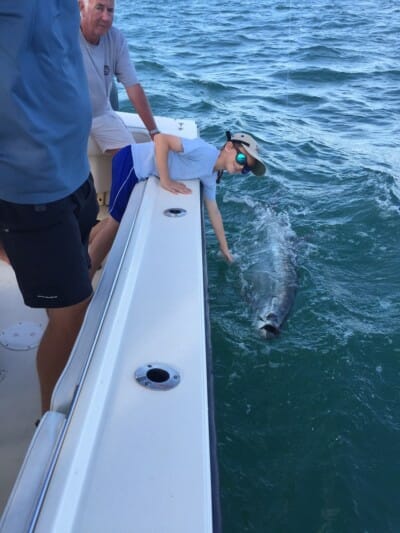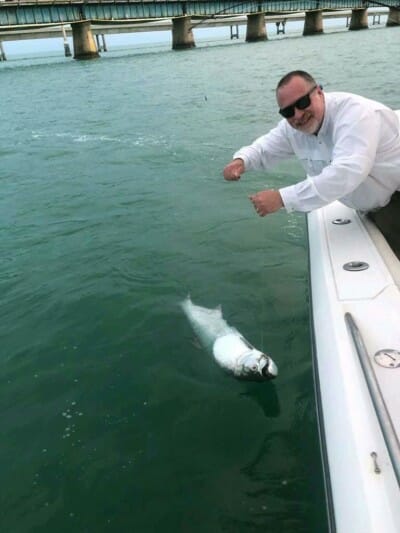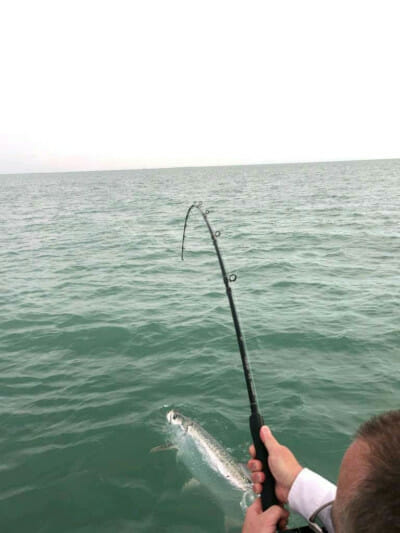How to Catch Tarpon In The Florida Keys
Learning how to catch Tarpon in the Florida Keys can be a daunting task without knowing a few tips to get you started. Whether you are looking to try it on your own or going to fish with a guide, my goal is to give you an idea of what to expect to get the most out of your Tarpon fishing experience. I have been fishing Tarpon professionally in Marathon Florida for 19 years. Tarpon is one of the most exciting fish to catch due to their acrobatic behavior and willingness to put up a really strong fight. We catch them on light tackle which makes it really fun! In the Florida Keys, we fish them under bridges and in the shallows depending on what the tides are doing. The first rule of thumb when it comes to catching tarpon is having good live bait.
Choosing the right bait

Tarpon will eat a variety of live bait so your best knowledge is to know what type of bait they are feeding on where you are fishing. An example is where crabs will work very well at one bridge but then another bridge not far away mullet or pinfish work better. The key is to know which bait works best at your location.
The perfect size bait is usually somewhere between eight and 10 inches long. If you can’t find any in this size range that is OK, they will still eat other sizes. If you need to decide between smaller mullet or larger ones go for the larger size. If you use a larger mullet you need to make sure to really hold your rod steady and let the Tarpon grab the bait. Tarpon do not have teeth, so you need to hold your rod still and give them a nice easy target.
Choosing the right equipment
The type of rod and reel to use is at your discretion. You want a reel that has a good drag and a rod that has some backbone to it. As for line we use on average 30 or 40 pound test. For your leader usually somewhere between 50 and 80 pound test. It will once again depend on what you are using for bait and on the current water clarity.
Hooks will vary depending on your bait. For your smaller baits and crabs usually something around a 5/0 hook. For your bigger baits such as mullet somewhere around a 8/0 up to a 10/0 hook will be needed. The majority of captains down here use circle hooks. It hooks nicely in the corner of the fish’s mouth and is easy to get out for a safe release.
The importance of boat etiquette
Tarpon are a big and powerful fish so you will need what we call a breakaway anchor system. This is where you have an anchor with anywhere from 50 to 80 feet of line with a buoy and some type of release clip at the end. When you hook a big tarpon, the idea is you need to unhook your anchor and leave it. You will not have time to pull your anchor up. Many of us captains put our breakaway anchor through a separate rope that runs from the front of the boat usually to the side cleat.
Then when we hook a fish we just undo the bridal line that is hooked on our side cleat. Then as we start backing up and chasing the fish the bridal line which is also hooked on the front of the boat just pulls through the clip on the end of the Anchorline and releases. Then your anchor which has a buoy at the end of the Anchorline just stays put. After you get done fighting your fish it is like having reserved parking. You come back to your buoy and hook back up and you are back fishing.
The golden rule of boat etiquette when Tarpon fishing, is to treat others the way you would want to be treated. If someone else is hooked up and their fish comes towards you, you do whatever is needed to get out of the other boats way. Remember, you might be hooked up and your fish goes towards someone else’s
boat or maybe even under their boat. Another important aspect of etiquette is coming back to your anchor. Never come straight back behind your anchor. Always come up and around the other boats that are fishing and then drop down from up-tide to your anchor.
There is no need to leave a giant wake and possibly knock other people off of their anchor. That will get you yelled at as quick as anything. Remember the golden rule of Tarpon fishing!


How to fight a Tarpon
So now you are sitting under a bridge, you have your anchor out, and you have your bait dangling in the current. Now let’s talk about what you do when you hook a fish. Tarpon are notorious for being able to throw a hook. Their mouths are as hard as bone and somehow you are going to try to put a hook through it. With most bites the key is to just let the Tarpon bend your rod over. The reason for this is so that you know the fish is swimming the other way as the hook tries to get set. Your hook up ratio will be much higher if you wait until the rod bends over first. As the rod bends over though, there is an old saying that you need to be ready for. You need to be ready to “bow to the king”. It goes against all of your instincts not to set the hook when the fish jumps but you actually need to do the opposite. As the fish jumps lower your rod and actually give him a little bit of slack in your line. This helps a lot because their head shakes are so violent that they can rip a hook out of their mouth very easily.
So remember to bow to the king and give the fish a little bit of slack so that hopefully your hook holds during their crazy giant leaps. So now that you have hooked up and are chasing your fish you want to make sure you try to stay within a reasonable distance close to your fish. They can be fighting right next to your boat and then the next thing you know they rip 100 yards of lining off and head straight back under a bridge. They will do just about everything that you would want out of a big and acrobatic fish.
Photo Time!
If you are lucky enough to get your fish up close to your boat hopefully you can get some nice pictures of it while it is swimming in the water next to your boat. They are a protected species now and strictly catch and release, this change has made It illegal to pull a tarpon out of the water for photos as reviving them can often make them vulnerable to predators. Well, hopefully, this article has helped you a little of an understanding of some of the basic fundamentals that go into catching a tarpon. If you do not want to hassle with renting a boat and figuring out what bait to use where and how to get the bait etc, just book a trip with me and I will put you on them. Good luck and tight lines!
Regards,
Captain Jeff Shelar
Catch ‘Em All Sportfishing





